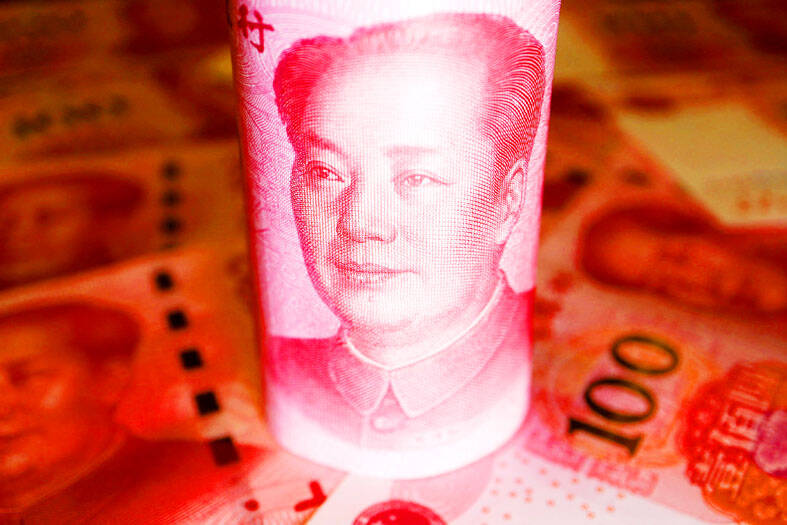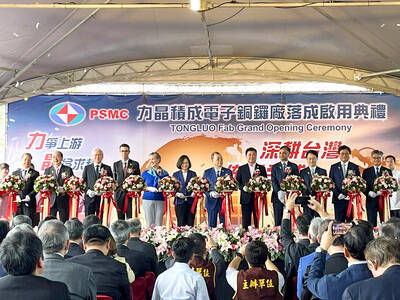China has handed out US$240 billion worth of bailout loans to 22 developing countries at risk of default over the past two decades, with the trend accelerating in the past few years, a report said yesterday.
Almost all the funds went to Belt and Road Initiative (BRI) countries such as Sri Lanka, Pakistan and Turkey — mostly low and middle-income nations that have received Chinese loans for infrastructure development, the study said.
The 40-page report by the US-based research lab AidData, the World Bank, the Harvard Kennedy School and the Kiel Institute for the World Economy showed that bailout loans had accelerated between 2016 and 2021, with Beijing doling out 80 percent of its rescue lending in that period.

Photo: Reuters
Around the world, BRI nations have come under strain as soaring inflation and interest rates, compounded by the lingering effects of the COVID-19 pandemic, have hurt their ability to repay debts.
The bailouts allow the countries to extend their loans and remain solvent, the report said.
China says that more than 150 countries have signed up to the BRI, a trillion-dollar global infrastructure push unveiled by President Xi Jinping (習近平) a decade ago.
Beijing says the initiative aims to deepen friendly trade relations with other nations, particularly in the developing world.
However, critics have long accused China of luring lower-income countries into debt traps by offering huge, unaffordable loans.
“China has developed a system of ‘Bailouts on the Belt and Road’ that helps recipient countries to avoid default, and continue servicing their BRI debts, at least in the short run,” the report said.
Compared with the IMF and the vast liquidity support extended by the US Federal Reserve, China’s bailouts remain small, but are growing quickly, the report said.
“Beijing has targeted a limited set of potential recipients, as almost all Chinese rescue loans have gone to low and middle-income BRI countries with significant debts outstanding to Chinese banks,” it said.
Chinese loans tend to be more opaque compared with other international lenders of last resort — and often come at an average interest rate of 5 percent, compared with a typical 2 percent rate on an IMF loan, the report said.
Many such agreements are so-called “rollovers,” in which the same short-term loans are repeatedly extended to refinance debts about to come due.
China this month agreed to restructure its loans to Sri Lanka, clearing the way for an IMF bailout of the nation.

purpose: Tesla’s CEO sought to meet senior Chinese officials to discuss the rollout of its ‘full self-driving’ software in China and approval to transfer data they had collected Tesla Inc CEO Elon Musk arrived in Beijing yesterday on an unannounced visit, where he is expected to meet senior officials to discuss the rollout of "full self-driving" (FSD) software and permission to transfer data overseas, according to a person with knowledge of the matter. Chinese state media reported that he met Premier Li Qiang (李強) in Beijing, during which Li told Musk that Tesla's development in China could be regarded as a successful example of US-China economic and trade cooperation. Musk confirmed his meeting with the premier yesterday with a post on social media platform X. "Honored to meet with Premier Li

Dutch brewing company Heineken NV on Friday announced an investment of NT$13.5 billion (US$414.62 million) over the next five years in Taiwan. The first multinational brewing company to operate in Taiwan, Heineken made the statement at a ceremony held at its brewery in Pingtung County. It also outlined its efforts to make the brewery “net zero” by 2030. Heineken has been in the Taiwanese market for 20 years, Heineken Taiwan managing director Jeff Wu (吳建甫) said. With strong support from local consumers, the Dutch brewery decided to transition from sales to manufacturing in the country, Wu said. Heineken assumed majority ownership and management rights

ARTIFICIAL INTELLIGENCE: The chipmaker last month raised its capital spending by 28 percent for this year to NT$32 billion from a previous estimate of NT$25 billion Contract chipmaker Powerchip Semiconductor Manufacturing Corp (力積電子) yesterday launched a new 12-inch fab, tapping into advanced chip-on-wafer-on-substrate (CoWoS) packaging technology to support rising demand for artificial intelligence (AI) devices. Powerchip is to offer interposers, one of three parts in CoWoS packaging technology, with shipments scheduled for the second half of this year, Powerchip chairman Frank Huang (黃崇仁) told reporters on the sidelines of a fab inauguration ceremony in the Tongluo Science Park (銅鑼科學園區) in Miaoli County yesterday. “We are working with customers to supply CoWoS-related business, utilizing part of this new fab’s capacity,” Huang said, adding that Powerchip intended to bridge

Microsoft Corp yesterday said that it would create Thailand’s first data center region to boost cloud and artificial intelligence (AI) infrastructure, promising AI training to more than 100,000 people to develop tech. Bangkok is a key economic player in Southeast Asia, but it has lagged behind Indonesia and Singapore when it comes to the tech industry. Thailand has an “incredible opportunity to build a digital-first, AI-powered future,” Microsoft chairman and chief executive officer Satya Nadella said at an event in Bangkok. Data center regions are physical locations that store computing infrastructure, allowing secure and reliable access to cloud platforms. The global embrace of AI